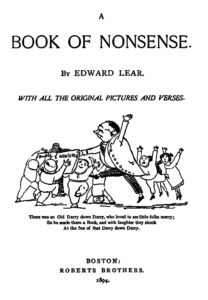Edward Lear’s Book of Nonsense
Listen to the Recess! Clip
| Author | Kevin Shortsleeve |
| Air Date | 2/8/2007 |

Book of Nonsense Transcript
One hundred and fifty-five years ago today, in London, at 26 Haymarket, the publisher Thomas McLean released a curious little book. It was entitled, The Book of Nonsense and the author, according to the cover, was a certain Derry Down Derry. Of course, the pseudonym did not fool the grandchildren of the Earl of Derby. For they knew who had written the limericks within. It was Edward Lear. The jolly gentleman had written the rhymes for them when he was engaged by the Earl to paint his menagerie.
The book sold for three shillings, six pence. But Lear earned very little from it, despite its immediate success. In fact, a few years later, he sold all the rights to the publishing house of Routledge and Warne for what Lear considered the hefty sum of 125 pounds. Lear was a hopeful landscape painter and travel writer. Though his art was indeed great, he never did seem to have much money. Lear joked in a letter to a friend that day. “I went to the city today, to put the 125 pounds I got for The Book of Nonsense into the funds,” he wrote. “And”, he went on, “It is doubtless a very unusual thing for an artist to put money aside, – for the whole way from Temple Bar to the Bank was crowded with carriages and peoples – so immense a sensation did this occurrence make.”
The book’s popularity only grew after that, and in Lear’s lifetime, it went into no less than seventeen printings. In 1866, one reviewer explained the book’s success when he wrote, “Never was a book published that so exactly hit the child’s mind as this one.” In Victorian England, this was very true. Much like our own Dr. Seuss heralded the death of Dick and Jane books, so too did Lear’s Book of Nonsense eclipse his stodgy competitors in the field of children’s publishing. Like Seuss, Lear’s poems clearly took the side of the child, and subsequently, also like Seuss, Lear eventually toted the moniker, “The child’s friend.”
The Book of Nonsense was not Lear’s greatest book. Other, later collections of his had a far greater impact on children’s poetry. But the importance of that first collection of seventy limericks cannot be overstated. The birth of nonsense literature, Edward Gorey once pointed out, was really the birth of the surrealist movement. You can draw a straight line from Edward Lear to Lewis Carroll to poets like T.S. Eliot and painters like Salvador Dali. And, in that subversive quality, you can see the base appeal of nonsense verse – for children don’t always want to see the world as it is – but how it could be – if only the world were inside-out.
Explore This Topic Further